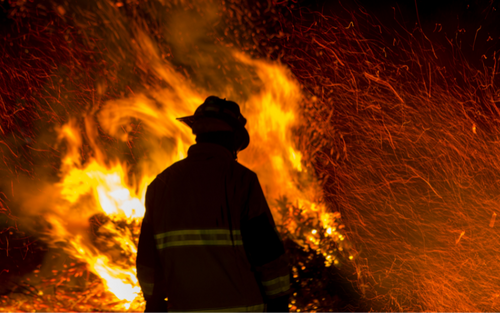Selecting PPE for Wildfire Cleanup
Wildfires are becoming increasingly common throughout the U.S. as temperatures rise year after year and conditions become more arid. Residents, businesses, and volunteers are often responsible for cleaning up wildfire debris, which can leave them vulnerable to health and safety hazards, including dust and airborne pollutants, structural hazards, mold, lead-based paint, and even asbestos. Many of these individuals do not have the proper waste disposal training. They need to wear the proper personal protective equipment (PPE) for wildfire cleanup to prevent long-term health issues.
Understanding the Risks
No two wildfires are exactly alike. These disasters affect each home or community differently. The PPE requirements vary widely based on the nature of the cleanup effort, primarily the extent of the damage and the age and condition of the building. Structures with asbestos, lead-based paint, mold, and other hazards may need additional protection. Before starting the cleanup process, individuals are encouraged to assess the worksite for potential hazards.
Those cleaning up should also understand their own potential risks for injury or illness. They may be discouraged from participating in the cleanup effort if they have physical limitations or underlying conditions that make them more susceptible to illness and disease. If the work exceeds the person’s abilities or experience level, they should contact a professional to remove the debris instead of doing it themselves.
When selecting PPE for wildfires, individuals should carefully read through the directions and user instructions of their gear before beginning the cleanup process.
Skin, Head, Eye, and Face Protection
You may encounter a range of potentially dangerous pollutants and contaminants in the aftermath of a wildfire. Any exposure to these hazards can lead to health problems, so those cleaning up will need to cover their faces, eyes, hands, and skin when removing them from the worksite.
Individuals should use protective eyewear or goggles to protect their face from flying debris. It should meet the American National Standards Institute (ANSI) Standard Z87.1 for safety eyewear. If approved, the goggles will have a small “Z87” symbol. The goggles should also seal over the person’s face — even if they are wearing glasses — to prevent debris from slipping through any slight openings.
They must also wear a hard hat when working around falling objects or debris. The hard hat should meet the ANSI Standard Z89.1 for proper head protection.
Cut-resistant gloves are also essential when moving or touching wildfire debris because the person could encounter sharp or hazardous objects and materials at the worksite. The gloves should be thick and durable enough to resist punctures and tears.
Exposure to mold, excess sun, and asbestos can lead to serious infection or skin damage. Volunteers should also wear safety workwear with long sleeves and pants when engaging in this work to protect their skin. The person should also use cooling devices and moisture-wicking clothing to increase ventilation and prevent heat stroke when working in extreme temperatures.
Respirators and Face Masks
Volunteers, residents and workers may also risk breathing in toxic particles and contaminants when working on the cleanup site. Exposure to ash, lead, silica dust, and other hazards can lead to lifelong health complications. Individuals should wear respirators or face masks approved by the National Institute for Occupational Safety and Health (NIOSH). Using either an N95 or P95 mask when working around debris in ventilated spaces is best. These masks filter out 95% of airborne particles to reduce exposure.
However, workers will need additional protection when working in confined spaces such as methane and carbon monoxide, where hazardous gases are present. The Occupational Safety and Health Administration (OSHA) has clear testing and protection requirements for those working around these hazardous gases. N95 masks do not filter out all the particles in the air, and they do not supply additional oxygen.
If there is little to no ventilation in the space, individuals will need to wear a respirator with a P100 filter and a half or full facepiece respirator, or a Powered Air Purifying Respirator (PAPR) with high efficiency (HE) filters. The P100 filter eliminates 100% of airborne particles, while the PAPR purifies the air to help the person breathe safely. They should also conduct a fit test to ensure the respirator fits properly before entering the confined space.
Responding to the aftermath of a wildfire can be treacherous, but workers, residents and volunteers can take precautions to protect themselves from serious injury or illness. Everyone in the area should wear the proper PPE for wildfire cleanup to reduce their exposure to these hazards.
Recent Posts
-
Customizing Gas Detectors: Tailoring Solutions to Fit Your Unique Requirements
In today’s diverse industrial landscape, a one-size-fits-all approach to safety simply doesn’t cu …Jul 3rd 2024 -
10 Ways to Prevent Wildfires
You can prevent wildfires by extinguishing flames before you leave the worksite. Avoid practicing …Jul 1st 2024 -
ANSI/ISEA 138 Safety Gloves: Ensuring Hand Protection
The human hand is an anatomical masterpiece and arguably the greatest tool attached to our bodies …Jun 25th 2024





